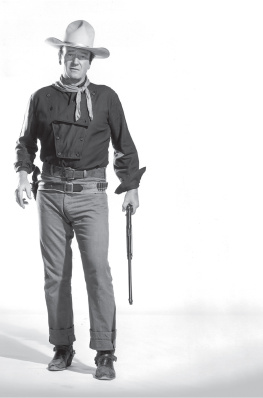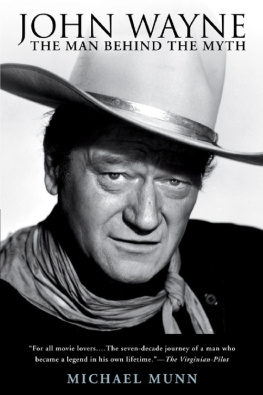Contents
Guide
Pagebreaks of the print version

The author and publisher have provided this e-book to you for your personal use only. You may not make this e-book publicly available in any way. Copyright infringement is against the law. If you believe the copy of this e-book you are reading infringes on the authors copyright, please notify the publisher at: us.macmillanusa.com/piracy.
This book is dedicated to the
memory of my parents,
Sylfest Peter Orwoll, Jr., and
Frances Patricia Giffin Orwoll,
who taught me that words matter.
This book is not meant to be an academic tome, but it is meant to be as accurate as possible.
All quotations are accompanied by a superscript number, which refers to the film source for each quote, as listed by number in appendix B. Films in that appendix are ordered chronologically, based on the U.S. premiere and/or general release dates. Release dates are sourced from the American Film Institutes AFI Catalog, Fred Landesmans exhaustive and well-researched The John Wayne Filmography, the Internet Movie Database (IMDb.com), and, when various dates are cited, a consensus of these and other references.
The categorization of quotes is the authors choosing. Quotes within each category are listed in chronological order, from the earliest film to the most recent. The author relied on actual screen credits for production notes and cast lists wherever possible, and confirmed them (and occasionally added to them) with information from Landesman, IMDb, and AFI.
As for the number of John Wayne films included in this book, 173 is an informed total, though not universally agreed on. Many references simply use more than 170. The Internet Movie Database lists 140 Wayne films, but doesnt include most of the many silent films in which Wayne was an extra or had only a walk-on role. Landesman places the total at 171 (169 features and two shorts), which includes The Sweetheart of Sigma Chi (1933), a film in which Waynes only scene was edited out of the final print, and for that reason, I have not included that film here. Landesmans list also includes Hollywood Handicap, but that was a short made for the Thalia Club, a private group, and not meant for public showings, so I have not included it here. Further, I have included four films that do not appear in the Landesman list: A Home-Made Man (1927) and The Draw-Back (1927), in both of which Wayne is identifiable; Seeing Stars (1928) (a researcher identified an uncredited Wayne after obtaining stills of this lost film, according to author Scott Eyman in John Wayne: The Life and Legend); and Cancel My Reservation (1972), a Bob Hope comedy in which Wayne has an uncredited cameo appearance as himself.
Details such as these, mostly found in the appendices of this book, are meant not to steal the editorial spotlight, but are presented here simply as background to support the main function of this book: to celebrate the memorable movie quotes of John Wayne.
M.O.
I watched every John Wayne movie because I couldnt track down a quote: Shoot low. They might be crawlin.
I love that quote, and just assumed it was from a Wayne movie because its so right. I went to the John Wayne official website and found a long list of quotes (a couple of which were actually spoken by him, too). But not the shoot low quote. Turns out, that was the motto of singing cowboy Monte Hale, who made a series of B Westerns for Republic Pictures in the 1940s and 50s. But it led me to wonder how many other supposed John Wayne quotes were either misattributed, inaccurate, or just plain made up.
And so I began my cinematic odyssey: to watch every John Wayne film and to transcribe as accurately as possible the most memorable bits of dialogue, the mumbled soliloquies, and the playful banter with his costars, in hope of creating a catalogue of authenticated verbatim lines. I would then break the quotes down into various categories (romance, duty, threats, etc.) and credit each of them to a specific film, so it could be traced back to the source for verification. I would list the title of each movie, its director, screenwriters, production notes, and original writing sourcestaken directly from the screen credits. It would be the ultimate compendium of cowboy quotes, the sine qua non of the stars sayings, the final word on what Hollywood put into John Waynes mouth and how he spat it out.
But for Gods sake, man, you must be asking yourself, why would a fully formed adult put himself through that?!
About a quarter of the way through watching his 173 films, I found myself thinking the same thing. Trouble is, you get that far into any major project, youre reluctant to waste all the time youve already invested by quitting.
So I admitted to myself what I knew to be true: I had become the reluctant Boswell to John Waynes Dr. Johnson. And there was no turning back.
My first mistake was to begin with those films I already knew were legendary: Stagecoach, The Quiet Man, The Shootist, and the like. But I shortly realized I had a long slog ahead of me, and the movies I was watching, in no particular order, lacked any context regarding Waynes career. How did his 1930s Saturday-matinee Westerns stack up against his World War II flicks of the 1940s and 50s? Did he improve as an actor as he got older, or was he just mailing it in with his later films? Did the quotes get juicier and more frequent with the advancing years? And so I decided to go back to the beginning, to his first role as a principal actor, The Big Trail (1930). (Later I would watch his earlier bit parts and walk-ons in silent films in the late 1920s, but, for obvious reasons, there were no quotes from those films.)
The Big Trail is a largely unsung masterpiece. Granted, Wayne was far from polished. His persona comes off as a bit shy, somewhat uncertain. But from the outset, John Wayne was a beautiful specimenbig, broad-shouldered, as handsome as the Marlboro Man. And boy, could he sit on a horse! Merely to watch him on the screen was to be assured that here was a movie star. And the film itself, in which Wayne plays a wagon-train scout, is a legitimate spectacle, with sprawling scenery and hundreds of extras. It must have seemed certain to producers as well as the moviegoing public that a great career was in the offing.
But then but then
The Big Trail proved not to be the vehicle to screen stardom one might have predicted for the young actor, owing at least in part to the recent crash of the stock market, the onset of the Depression, and the resulting inability of some movie theaters to pay for the abundance of films they once offered. So Wayne, still a working stiff and not yet a movie star, continued accepting bit parts and secondary roles in third-rate films, as he had for years in silent movies leading up to The Big Trail. Some of those roles are incomprehensibly awful, as in The Deceiver (1931), in which Wayne portrays a corpus delicti. But it was also in the early 1930s that Wayne found his footing as a cowboy star in a series of cheapie Westerns made on Poverty Row, the industrys nickname for Hollywoods low-budget studios.
There is a small coterie of film watchers who love John Waynes early oaters, but theyre not to everyones tastes. The plots are usually the same throughoutthe good guy is perceived to be a bad guy until he can prove that he really is a good guy, and possibly kiss a plain girl somewhere in between. Either that or the innocent settlers are about to be bamboozled by a tough pistolero or a fancy city slicker until Wayne enters the scene and puts the villain in his place, usually after a speedy horse chase. (An interesting note about these early Waynesters: Although there was a fair amount of fisticuffs, it was far exceeded by chases on horseback over dusty trails.)









